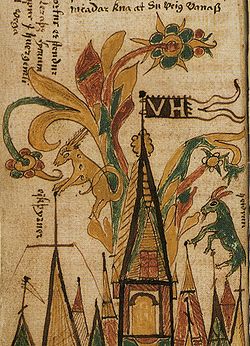
Eikþyrnir
Encyclopedia

Valhalla
In Norse mythology, Valhalla is a majestic, enormous hall located in Asgard, ruled over by the god Odin. Chosen by Odin, half of those that die in combat travel to Valhalla upon death, led by valkyries, while the other half go to the goddess Freyja's field Fólkvangr...
in Norse mythology
Norse mythology
Norse mythology, a subset of Germanic mythology, is the overall term for the myths, legends and beliefs about supernatural beings of Norse pagans. It flourished prior to the Christianization of Scandinavia, during the Early Middle Ages, and passed into Nordic folklore, with some aspects surviving...
. The following is related in the Gylfaginning
Gylfaginning
Gylfaginning, or the Tricking of Gylfi , is the first part of Snorri Sturluson's Prose Edda after Prologue. The Gylfaginning deals with the creation and destruction of the world of the Norse gods, and many other aspects of Norse mythology...
section of Snorri Sturluson
Snorri Sturluson
Snorri Sturluson was an Icelandic historian, poet, and politician. He was twice elected lawspeaker at the Icelandic parliament, the Althing...
's Prose Edda
Prose Edda
The Prose Edda, also known as the Younger Edda, Snorri's Edda or simply Edda, is an Icelandic collection of four sections interspersed with excerpts from earlier skaldic and Eddic poetry containing tales from Nordic mythology...
after the description of Heiðrún
Heiðrún
Heiðrún is a goat in Norse mythology, which consumes the foliage of the tree Læraðr and produces mead for the einherjar. She is described in the Poetic Edda and Prose Edda.-Prose Edda:-Poetic Edda:...
.
Enn er meira mark at of hjörtinn Eirþyrni, er stendr á Valhöll ok bítr af limum þess trés, en af hornum |
Even more worthy of note is the hart Eikthyrni, which stands in Valhall and bites from the limbs of the tree; and from his horns distils such abundant exudation that it comes down into Hvergelmir Hvergelmir Hvergelmir is the wellspring of cold in Niflheim in Norse mythology. All cold rivers are said to come from here, and it was said to be the source of the eleven rivers, Élivágar. Above the spring, the serpent Níðhöggr gnaws on one of the roots of the world tree, Yggdrasil.-References:* Orchard,... , and from thence fall those rivers called thus: Síd, Víd, Søkin, Eikin, Svöl, Gunnthrá, Fjörm, Fimbulthul, Gípul, Göpul, Gömul, Geirvimul. Those fall about the abodes of the Æsir Æsir In Old Norse, áss is the term denoting a member of the principal pantheon in Norse paganism. This pantheon includes Odin, Frigg, Thor, Baldr and Tyr. The second pantheon comprises the Vanir... ; these also are recorded: Thyn, Vín, Thöll, Höll, Grád, Gunnthráin, Nyt, Nöt, Nönn, Hrönn, Vína, Vegsvinn, Thjódnuma. — Brodeur's translation |
Brodeur follows the text of the T manuscript of the Prose Edda in putting the stag í Valhöll, "in Valhall", rather than á Valhöll, "upon Valhall", as the other manuscripts do. The more recent translation by Anthony Faulkes puts the stag on top of the building which seems much more natural from the context and weight of the evidence.
Snorri's source for this information was almost certainly Grímnismál
Grímnismál
Grímnismál is one of the mythological poems of the Poetic Edda. It is preserved in the Codex Regius manuscript and the AM 748 I 4to fragment. It is spoken through the voice of Grímnir, one of the many guises of the god Odin, who is tortured by King Geirröth...
where the following strophes are found.
|
Odin Odin is a major god in Norse mythology and the ruler of Asgard. Homologous with the Anglo-Saxon "Wōden" and the Old High German "Wotan", the name is descended from Proto-Germanic "*Wodanaz" or "*Wōđanaz".... ’s hall,
|

